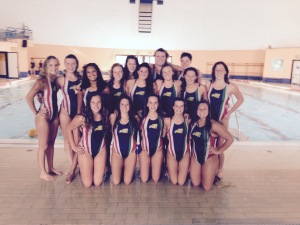Fansmanship Podcast Episode 217 – Chris Sylvester and Brint Wahlberg
It’s another podcast episode! Cal Poly basketball teams are at the Big...
This past weekend was conference championship tournament time for all NCAA men’s water polo teams. Similar to most conference tournaments of any sport, the winner receives an automatic berth to compete in the NCAA Men’s Water Polo Championships. This year’s are December 6-7 at Canyonview Pool on the campus of UC San Diego. I was able to watch both the Mountain Pacific Sports Federation (think PAC-12) championship game between Stanford and Long Beach State, as well as the Western Water Polo Association (think Big West meets the WCC) championship game between UC San Diego and Loyola Marymount. With Stanford and UC San Diego prevailing, both games were competitive and the athleticism was outstanding!
When watching any team play, I always pull up the rosters, secretly hoping for central coast representation. But I am constantly seeing is a trend that has been occurring in water polo the past five years: more and more international student-athletes playing at the collegiate level.

Water is one of the most popular sports in Europe: on a recent trip to Greece, water polo balls were found being sold at beach stores to be used at nearby beaches.
The top four teams in NCAA Men’s Water Polo right now include Stanford, Long Beach State, UCLA and USC. These four teams combine a total of 13 international student-athletes (Long Beach State features the most: seven). Although two of the 13 student-athletes hail from Australia and Brazil, an overwhelming majority of them come from Europe. So why all the international play — specifically European play — in the NCAA Water Polo landscape?
The popularity of water polo in Europe is unbelievable! In some eastern European countries, it is the most popular sport to its countrymen. They play, live and breathe water polo. Part of the reason water polo is so popular is because it can be played professionally throughout Europe. Similar to our professional sports leagues, Europe is home to the LEN Champions League (Ligue Europeenne de Natation), consisting of professional teams from up to 18 countries. It is an incredibly competitive league where the best of the best play. You must be of the highest caliber to be a member of a team (Olympic and/or national team status representing your home country).
Many young European players have the opportunity to play in this professional league, or alternatively in a lower U-19 level (equivalent to minor league baseball). Only the top young talented athletes play on the professional level; however, if you don’t make the professional cut, and you are young and want to continue to play, there is nowhere to go. These young athletes do not have a European university system that provides opportunities for athletes to train and become a better player before heading back into the international scene. We are seeing an increase in International student-athletes because our collegiate athletic system is exactly what they need and want: a high level training ground that promotes athletic growth, a healthy well-balanced life-style, as well as educational opportunities.

The Arroyo Grande High School Girls Water Polo Team embracing international integration by traveling to Italy in the Summer of 2013.
The influx of international student-athletes is seen on both the men’s and women’s side of collegiate water polo. As a player did I think this was unfair? Well, it definitely changed the landscape of collegiate water polo. The level of play increased dramatically when international student-athletes, many of whom were current Olympians or junior national team members for their country, played on college teams. But, my teammates and I tried to stay positive and embraced it. By playing against international student-athletes, they were just making me and my teammates better water polo players.
Many teams are also embracing the international integration. In the summer of 2013, Coach Steven Allen of Arroyo Grande High School took his Lady Eagles to Italy for two weeks of training, competition and culture. His goal was to bridge the gap between the United States style of play and the European way, exposing his athletes to a different way of training and game execution. The young athletes learned a fast paced style of the game, including a swim speed that is not often seen on the central coast. But most importantly, they learned the local culture at a deeper level than just seeing the sites or playing against a foreign team. The athletes were completely submerged into the culture, even residing with local Italian water polo families during their two weeks. They came home with a heightened appreciation for another culture and learned to value the international differences in the water and out.
So why is water polo extremely popular in Europe but has a difficult time holding its own in the United States? Well, it’s up for debate. My opinion: the lack of our professional sports in Europe, such as football, basketball and baseball, allows for Olympic sports to gain exposure. But, with increased television exposure of water polo (thank you NBC and PAC-12 network) along with the live-streaming of many collegiate and even high school championships, water polo in the United States is surpassing other Olympic sports. I don’t think it will ever be as popular as it is overseas, but it is certainly gaining momentum.
The 2014 NCAA Men’s Water Polo Final Four Championships will be held December 6-7, 2014 at Canyonview Pool on the campus of UC San Diego. Four of the best teams in men’s collegiate water polo will gather to determine the national champion.
It’s another podcast episode! Cal Poly basketball teams are at the Big...
One of my favorite authors, Jeff Pearlman joins this edition of the...
Donovan Fields is one of the most joyous basketball players I’ve ever...
With the tournament more than underway and the sweet sixteen fast approaching,...
(Article by Luke “Loco” Johnson. Forgive website faux pas.) The genius of...
* Team Records accurate as of Friday morning, 8:39 A.M. The hyped hoopla...
